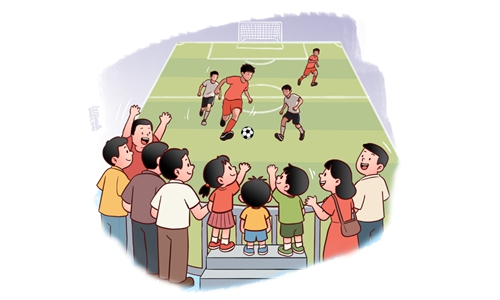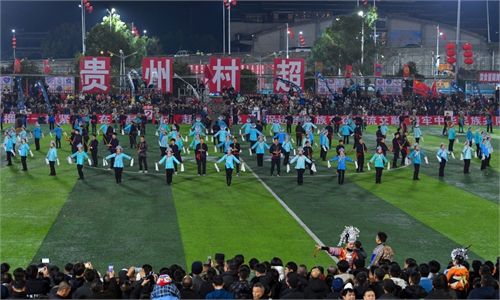ARTS / CULTURE & LEISURE
Authenticity, local relevance make ‘Suchao’ lasting feat

Illustration: Liu Xiangya/GT
Since its launch, the Jiangsu Football City League (JFCL) in East China's Jiangsu Province, affectionately known as "Suchao" (Lit: Super League in Jiangsu) in Chinese, has defied initial skepticism about its fleeting popularity.While some predicted its popularity would wane as time passed by, the league has instead become a cultural phenomenon, with discussions ranging from defending Changzhou's name to debating the merits of juicy peaches and salted ducks - both symbols of the regional identities of Jiangsu cities.
These conversations have extended far beyond the province's borders, highlighting Suchao's unique ability to transcend sports and become a catalyst for broader social and cultural interaction.
At its core, Suchao has transformed football pitches into dynamic hubs that link the province's diverse cities through tourism. Each home game serves as a strategic opportunity for host cities to showcase their unique attractions, creating a "sports plus tourism" ecosystem that benefits both local economies and visiting fans.
Nanjing, the capital city, has paired its home matches with discounts such as the Qinhuai River night tour for football match tickets holders, a move that led to a staggering increase in night tour bookings. Initiatives such as these have not only boosted tourism revenue but also allowed fans, especially visiting fans, to experience Nanjing's historic charm, blending the excitement of a match with the allure of cultural heritage.
Suzhou, known for its classical gardens and water towns, exemplified cross-city collaboration by offering free admission to Tongli Ancient Town for fans from Yangzhou, a traditional rival city in southern Jiangsu. This gesture transcended sports rivalries, promoting cultural exchange and mutual appreciation.
Changzhou, whose team has yet to win a match, creatively turned a sports setback into a tourism boon by offering free tickets to the local Tianmu Lake Scenic Area. This playful yet strategic move not only attracted fans but also highlighted Changzhou's ability to transform challenges into opportunities for civic engagement and tourism promotion.
These initiatives demonstrate that Suchao is more than a sports league. Each match day becomes a curated experience in which cities showcase their unique identities, turning fleeting sports spectators into potential tourists. The economic impact is tangible: increased hotel bookings and retail sales in host cities. More importantly, it fosters a sense of regional pride and connectivity.
Beyond tourism, Suchao has masterfully tapped into Jiangsu's rich tapestry of regional cultures, transforming historical and folklore symbols into shared cultural experiences.
Cities like Xuzhou and Suqian, historically linked to the Chu-Han Contention (a pivotal period in Chinese history between two warlords), have used the league to revive this narrative through fan activities such as singing battles and cultural relic exhibitions. Lianyungang, associated with the classic novel Journey to the West, leveraged its "Monkey King" heritage through themed fan performances and stadium decorations.
The league's success in spreading these cultural narratives owes much to social media and digital innovation. Clips of young players' spectacular goals and blocks go viral on short-video platforms, accompanied by humorous AI-generated videos that inject modern creativity into traditional symbols.
In doing so, Suchao has created a form of "cultural carnival" where fans from different cities not only cheer for their teams but also learn about and appreciate each other' heritages. This transcends the usual sports rivalry, fostering a sense of collective identity among Jiangsu's residents while introducing the province's diversity to the rest of China.
Suchao's most significant contribution lies in its demonstration of how a sports league can serve as an engine for urban vitality by integrating sports with culture, consumption, and technology. In the era of the digital economy, traditional sports events often struggle to expand their influence beyond niche audiences. Suchao breaks this mold by creating a cross-sectoral ecosystem where sports, tourism, culture and commerce, reinforces each other.
Economically, the league drives consumption through affordable ticket prices as low as 10 yuan (roughly $1.40). The upcoming Nanjing vs Suzhou match on Saturday at the iconic Nanjing Olympic Sports Center, which previously witnessed the second highest attendance of a professional domestic Chinese Super League (CSL) match at 65,769 people, is expected to challenge that record as the amateur Nanjing-Suzhou game has sold out.
Suchao proves that football focused on grassroots participation and community engagement has immense appeal. It has reignited public passion for football, a sport that in China has long been overshadowed by the focus on the professional level and national team performances. The tickets for the match sold out in seconds after going on sale on June 27. The ticketing company showed that over 800,000 people had tracked the sale.
Suchao's success challenges the traditional dichotomy between professional and amateur football. In China, the emphasis on championship football has often neglected the grassroots level. The success of Suchao shows that social football and professional football can coexist and complement each other: While the CSL aims for sporting excellence, Suchao nurtures football culture, creating a pipeline of fans and potential players while fostering community cohesion.
Other regions have taken notice. Zhejiang has launched its own league and Sichuan plans a Chuanchao. However, its success cannot be simply replicated through copy-paste approaches. Jiangsu's uniqueness lies in its diverse regional identities, robust infrastructure and cultural richness, elements that other provinces must adapt to their own contexts. The key takeaway is the importance of authenticity and local relevance.
The author is a reporter with the Global Times. life@globaltimes.com.cn



